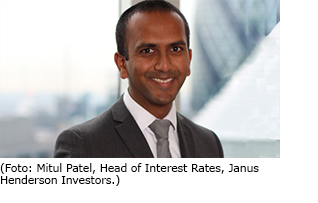
Janus Henderson: Interpreting the UK rate hike
The Bank of England raised its benchmark interest rate by a quarter of a percentage point today to 0.5%. The first rate hike for the bank in ten years is seen as a dovish move by the markets. Members of Janus Henderson’s Fixed Income Investment Strategy Group, Mitul Patel and Andrew Mulliner, share their thoughts on the implications and the markets’ expectations of policy direction.
02.11.2017 | 12:09 Uhr
 Andrew Mulliner, Portfolio Manager
Andrew Mulliner, Portfolio Manager
The Bank of England delivered a rate hike as expected, with the vote split 7-2 (again as expected). The interesting element was the accompanying statement in which the bank removed a sentence regarding ‘markets not pricing an appropriate level of tightening over the forecast period’, suggesting future rate hikes will be very slow in coming indeed. Net result: this is a dovish hike.
 Mitul Patel, Head of Interest Rates
Mitul Patel, Head of Interest Rates
As expected, the Bank of England raised rates by 25 basis points today; the first rate rise in the UK for over a decade. In the accompanying statement, the Monetary Policy Committee (MPC) omitted a sentence that it had included in previous statements, which suggested that rates may need to rise by more than the market expects.
The markets interpreted this as suggestive of the MPC being comfortable with them currently pricing in two further hikes over the coming three years. Its inflation forecast suggested that on this expected path of policy rates, inflation would still be above the 2% target, in three years’ time.
Historically an inflation overshoot at the 3-year horizon would be interpreted hawkishly, and imply a greater degree of tightening would be needed. However, the current substantial risks in both directions suggest that the Bank of England will tread cautiously and today’s hike is unlikely to be followed up by any further hikes in the next six months, unless the economy performs much more strongly than expected.
Many commentators believe that this rate hike is purely in response to temporarily high rates of inflation, induced by prior currency weakness, and as such is likely to prove a mistake. The Bank of England continues to signal, however, that it is hiking in response to an erosion in spare capacity and limited slack in the labour market.
Stagnant productivity and lower population growth rates suggest that the UK may now not be capable of growing much more than 1.5% without imparting upwards pressure on inflation. This suggests that economic data, such as gross domestic product (GDP) growth at 1.5%, which would have been disappointing in the past, may now prove strong enough to lead to further rate hikes.
Should Brexit prove to have a bigger drag on the economy than currently expected, rates are likely to stay on hold for a long period, or potentially be cut back again if the unemployment rate starts rising.



Diesen Beitrag teilen: